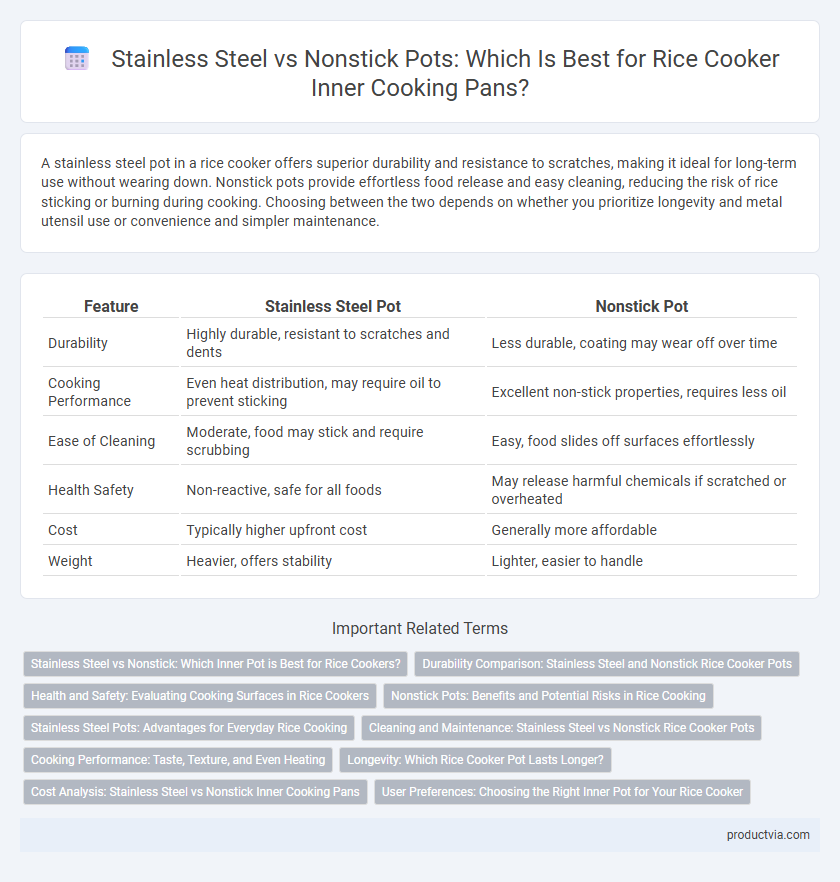A stainless steel pot in a rice cooker offers superior durability and resistance to scratches, making it ideal for long-term use without wearing down. Nonstick pots provide effortless food release and easy cleaning, reducing the risk of rice sticking or burning during cooking. Choosing between the two depends on whether you prioritize longevity and metal utensil use or convenience and simpler maintenance.
Table of Comparison
| Feature | Stainless Steel Pot | Nonstick Pot |
|---|---|---|
| Durability | Highly durable, resistant to scratches and dents | Less durable, coating may wear off over time |
| Cooking Performance | Even heat distribution, may require oil to prevent sticking | Excellent non-stick properties, requires less oil |
| Ease of Cleaning | Moderate, food may stick and require scrubbing | Easy, food slides off surfaces effortlessly |
| Health Safety | Non-reactive, safe for all foods | May release harmful chemicals if scratched or overheated |
| Cost | Typically higher upfront cost | Generally more affordable |
| Weight | Heavier, offers stability | Lighter, easier to handle |
Stainless Steel vs Nonstick: Which Inner Pot is Best for Rice Cookers?
Stainless steel inner pots provide superior durability and resist scratches, making them ideal for long-term use in rice cookers. Nonstick pots offer easy food release and quick cleanup but may wear out faster due to coating degradation. Choosing between stainless steel and nonstick inner pots depends on prioritizing longevity and health safety versus convenience and cleaning efficiency.
Durability Comparison: Stainless Steel and Nonstick Rice Cooker Pots
Stainless steel pots in rice cookers offer superior durability, resisting scratches, dents, and high temperatures without degrading over time. Nonstick pots provide easy food release and cleaning but tend to wear out faster, with coatings prone to peeling or scratching after prolonged use. Investing in a stainless steel inner pot ensures long-term performance and reliability, especially for frequent cooking.
Health and Safety: Evaluating Cooking Surfaces in Rice Cookers
Stainless steel pots in rice cookers are prized for their durability, resistance to scratching, and non-reactive surface, ensuring no harmful chemicals leach into food during cooking. Nonstick pots offer ease of cleaning and prevent rice from sticking, but concerns remain regarding potential release of toxic compounds if the coating degrades or overheats. Prioritizing health and safety, stainless steel offers a safer long-term option without the risk of chemical exposure linked to some nonstick coatings.
Nonstick Pots: Benefits and Potential Risks in Rice Cooking
Nonstick pots in rice cookers offer easy food release and quick cleanup, enhancing convenience during meal preparation. They reduce the need for added oils, promoting healthier rice cooking and preventing sticking issues common with stainless steel pots. However, nonstick coatings may degrade over time with high heat, potentially releasing harmful chemicals if scratched or damaged.
Stainless Steel Pots: Advantages for Everyday Rice Cooking
Stainless steel pots offer superior durability and resistance to scratches and corrosion, making them ideal for everyday rice cooking. Their non-reactive surface ensures flavors remain pure, while even heat distribution prevents hot spots for perfectly cooked rice. Easy maintenance and the ability to withstand high temperatures provide long-lasting performance without the risk of coating damage common in nonstick pots.
Cleaning and Maintenance: Stainless Steel vs Nonstick Rice Cooker Pots
Stainless steel rice cooker pots offer superior durability and resistance to scratches, making them easier to clean with abrasive scrubbers and dishwasher-safe detergents, whereas nonstick pots require gentle handling to avoid coating damage and are best cleaned with soft sponges. Maintenance for stainless steel involves occasional polishing to prevent discoloration, while nonstick pans often need careful monitoring to prevent peeling and may require replacement sooner. Choosing stainless steel ensures long-term usability and robust cleaning options, while nonstick pots provide convenience but demand delicate care.
Cooking Performance: Taste, Texture, and Even Heating
Stainless steel pots in rice cookers provide superior heat distribution, ensuring even cooking and consistent texture with a natural, unaltered taste. Nonstick pots offer easy food release and simpler cleaning but may result in less even heating, occasionally causing unevenly cooked grains or slight texture variations. The choice between stainless steel and nonstick inner pans directly impacts cooking performance, with stainless steel favored for durability and optimal taste preservation.
Longevity: Which Rice Cooker Pot Lasts Longer?
Stainless steel pots for rice cookers offer superior longevity due to their resistance to scratches, dents, and high temperatures, making them ideal for heavy, long-term use. Nonstick pots tend to wear down over time as the coating degrades or peels, reducing their lifespan significantly when exposed to frequent stirring or metal utensils. Choosing a stainless steel inner pot ensures a durable, corrosion-resistant rice cooker component that maintains performance and safety over years of regular cooking.
Cost Analysis: Stainless Steel vs Nonstick Inner Cooking Pans
Stainless steel inner cooking pans generally cost more upfront due to their durable, rust-resistant material, making them a long-term investment for rice cooker users. Nonstick inner pots often come at a lower initial price, offering affordability but potentially incurring replacement costs over time due to coating wear and reduced durability. Evaluating cost efficiency involves balancing stainless steel's longevity against nonstick pans' budget-friendly appeal and maintenance needs.
User Preferences: Choosing the Right Inner Pot for Your Rice Cooker
Stainless steel pots offer durability, resistance to scratches, and maintain the natural flavor of rice, appealing to users who prioritize longevity and easy cleaning without chemical concerns. Nonstick pots provide effortless food release and quick cleanup, ideal for those who value convenience and less scrubbing after cooking. User preferences often depend on cooking habits, with stainless steel favored for high-heat cooking and nonstick preferred for everyday use and gentle maintenance.
Stainless Steel Pot vs Nonstick Pot for inner cooking pan Infographic

 productvia.com
productvia.com